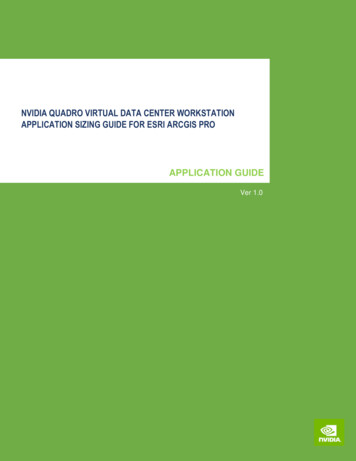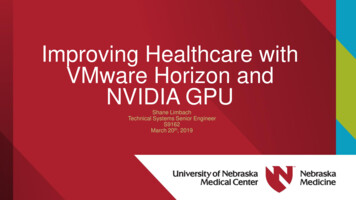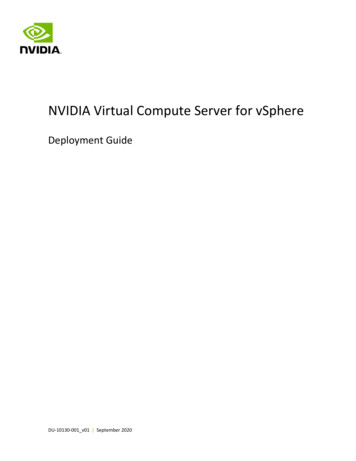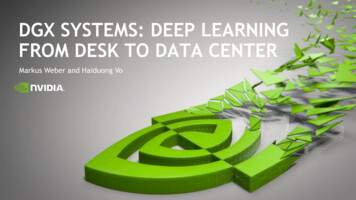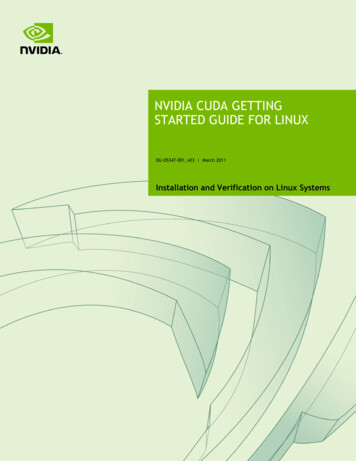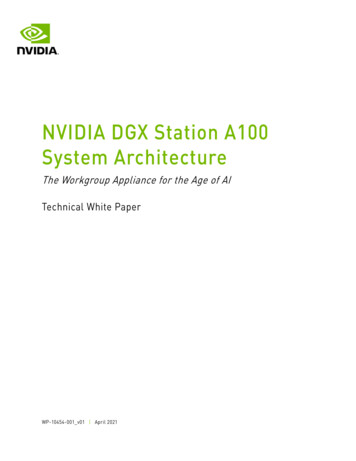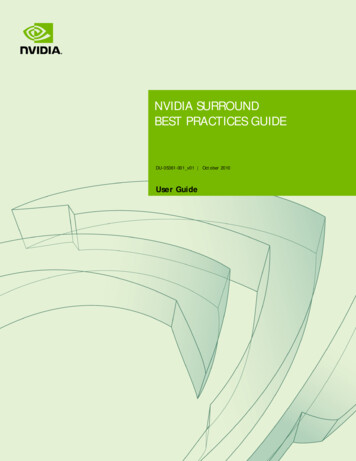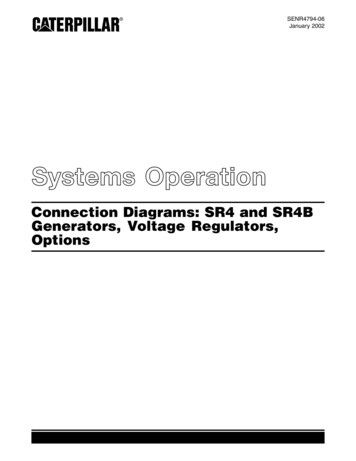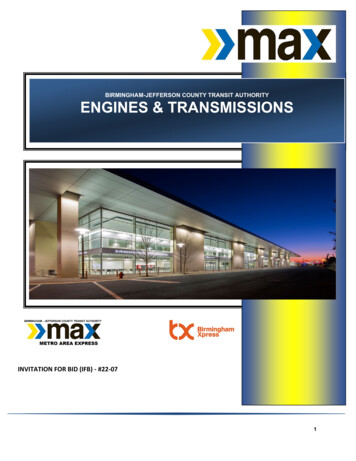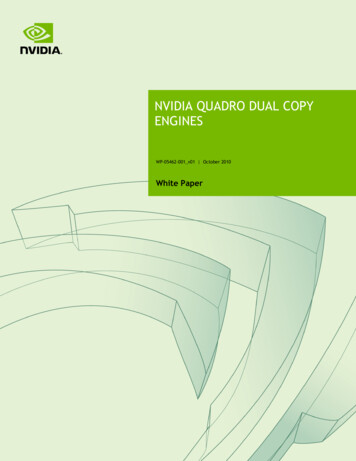
Transcription
NVIDIA QUADRO DUAL COPYENGINESWP-05462-001 v01 October 2010White Paper
DOCUMENT CHANGE HISTORYWP-05462-001 v01VersionDateAuthorsDescription of Change01October 14, 2010SV, SMInitial ReleaseNVIDIA Quadro Dual Copy EnginesWP-05462-001 v01 ii
TABLE OF CONTENTSUsing Quadro Dual Copy Engines. 1Introduction. 1Current Streaming Approaches. 3Synchronous Downloads . 3CPU Asynchronous Downloads with PBOs . 4GPU Asynchronous transfers with Quadro Dual Copy Engines . 6Synchronization . 7Multi-Threaded Downloads . 7Readback with Quadro Dual Copy Engines . 9Results . 10References . 12NVIDIA Quadro Dual Copy EnginesWP-05462-001 v01 iii
LIST OF FIGURESFigure 1.Figure 2.Figure 3.Figure 4.Figure 5.Figure 6.Typical System Architecture Block Diagram . 2Synchronous Downloads With No Overlap . 3CPU Asynchronous Downloads with Ping Pong PBOs . 4Quadro Dual Copy Engine Block Diagram and Application Layout . 6GPU Asynchronous Transfers with Dual Copy Engines . 7Download Process Performance Comparison . 11NVIDIA Quadro Dual Copy EnginesWP-05462-001 v01 iv
NVIDIA QUADRO DUAL COPY ENGINESINTRODUCTIONThe evolution of high-performance and fully programmable graphics processing units(GPUs) has led to tremendous advancements in graphics and parallel computing. Withthe introduction of the new NVIDIA Quadro professional graphics solutions, based onthe innovative NVIDIA Fermi architecture [1], application developers greatly optimizedata throughput for maximized application performance.In the past, data transfers would stall due to architectural limitations in synchronizingthe data with the GPU processing. For example, during texture uploads or frame bufferreadbacks, the GPU is blocked from processing and incurs a heavy context switch. Thissynchronization requirement of traditional GPUs limits the overall processingthroughput capabilities and creates bottlenecks with high performance applications.With the introduction of the Fermi architecture, the new Quadro solutions featureNVIDIA Dual Copy Engines that enable asynchronous data transfers with concurrent 3way overlap. The current set of data can be processed while the previous set can bereadback from the GPU, and the next set is uploaded. Figure 1 shows a typical systemarchitecture block diagram. It is seen that even with high performance PCI Express 16bandwidth, the Quadro GPU memory bandwidth is many orders faster than the bus andthe CPU RAM bandwidth. By overlapping transfers and compute, the PCI Expressmemory latency can be hidden so that by the time the GPU is ready to process a piece ofdata, it is already fetched into the high bandwidth area.NVIDIA Quadro Dual Copy EnginesWP-05462-001 v01 1
NVIDIA Quadro Dual Copy EnginesFigure 1.Typical System Architecture Block DiagramSome examples for overlapped transfers with Quadro dual copy engines are: Video processing or time-varying geometry/volumes including post processing,video upload to maintain a frame rate and readback to save to disk. Parallel numerical simulation that uses domain decomposition techniques such asFinite Element/Volume. The Quadro GPU can be used as a co-processor that is able todownload, process and readback the various subdomains with CPU scheduling. Parallel rendering - When a scene is divided and rendered across multiple QuadroGPUs with the color and depth readback for composition, parallelizing readback willspeed up the pipeline. Likewise for sort-first implementation where at every framethe data has to be streamed to the GPU based on the viewpoint. Data bricking for large image, terrains and volumes. Bricks or LODs are paged inand out as needed in another thread without disruption to the rendering thread. Cache for OS – OS can page in and out textures as needed eliminating shadow copiesin RAM.NVIDIA Quadro Dual Copy EnginesWP-05462-001 v01 2
NVIDIA Quadro Dual Copy EnginesCURRENT STREAMING APPROACHESA typical download-process-readback pipeline can be broken down into the following: Copy – involves CPU cycles in data conversions if any to native GPU formats andmemcpy from the application memory space to the driver space. Download – the time for the actual data transfer on PCI Express from host to device. Process – GPU cycles for rendering and compute. Readback – time for the data transfer from device back to host.To achieve maximum end-to-end throughput on the GPU, maximum overlap is requiredbetween these various components in the pipeline.Synchronous DownloadsThe straightforward download method for textures is to call glTexSubImage whichinvolves and blocks the CPU while copying data from user space to the driver space andsubsequent data transfer on the bus to the GPU. Figure 2 illustrates the inefficiency ofthis method as the GPU is idle while the CPU is busy with the memcpy.Figure 2.Synchronous Downloads With No OverlapNVIDIA Quadro Dual Copy EnginesWP-05462-001 v01 3
NVIDIA Quadro Dual Copy O - read from file to pDataglBindTexture(GL TEXTURE 2D, texID);//TODO – Set Texture Params like wrap, filter using glTexParameteriglTexImage2D(GL TEXTURE 2D,0,GL RGBA8,width,height,0,GL RGBA,GL UNSIGNED BYTE,pData[0]);DrawglBindTexture(GL TEXTURE 2D, texID);glTexSubImage2D(GL TEXTURE 2D,0, 0,0,width,height,GL RGBA, GL UNSIGNED BYTE, m pData[m curBrick]);//TODO - Call drawing code hereCPU Asynchronous Downloads with PBOsThe OpenGL PBO [2] mechanism provides for transfers that are asynchronous on theCPU. If an application can schedule enough work between initiating the transfer andactually using the data, CPU asynchronous transfers are possible. In this case, theglTexSubImage call operates with little CPU intervention. PBOs allow direct read/writeinto GPU driver memory eliminating need for additional memcpys. The CPU after thecopy operation does not stall while the transfer takes place and can continue on toprocess the next frame. However, downloads and uploads still involve GPU contextswitch and cannot be done in parallel with the GPU processing or drawing. MultiplePBOs can potentially speed up the transfers. A ping pong version is shown in Figure 3.Figure 3.CPU Asynchronous Downloads with Ping Pong PBOsNVIDIA Quadro Dual Copy EnginesWP-05462-001 v01 4
NVIDIA Quadro Dual Copy EnginesInitializationGLuint pboIds[2];glGenBuffersARB(2, pboIds); //Allocate 2 PBO’sglBindBufferARB(GL PIXEL UNPACK BUFFER ARB, pboIds[0]);glBufferDataARB(GL PIXEL UNPACK BUFFER ARB,width*height*sizeof(GLubyte*nComponents),0,GL STREAM DRAW ARB);glBindBufferARB(GL PIXEL UNPACK BUFFER ARB, pboIds[1]);glBufferDataARB(GL PIXEL UNPACK BUFFER ARB,width*height*sizeof(GLubyte)*nComponents,0,GL STREAM DRAW ARB);glBindBufferARB(GL PIXEL UNPACK BUFFER ARB, 0);//TODO – Same texture initialization from “texture streaming” sectionDrawstatic unsigned int curPBO 0;glBindTexture(GL TEXTURE 2D,texId);glBindBufferARB(GL PIXEL UNPACK BUFFER ARB, pboIds[curPBO]); //bind pbo//Copy pixels from pbo to texture objectglTexSubImage2D(GL TEXTURE 2D,0,0,0,xdim,ydim,GL RGBA,GL UNSIGNED BYTE,0);//bind next pbo for app- pbo transferglBindBufferARB(GL PIXEL UNPACK BUFFER ARB, m pboIds[1-curPBO]);//bind pbo//to prevent sync issue in case GPU is still working with the dataglBufferDataARB(GL PIXEL UNPACK BUFFER ARB,xdim*ydim*sizeof(GLubyte)*nComponents, 0, GL STREAM DRAW ARB);GLubyte* ptr (GLubyte*)glMapBufferARB(GL PIXEL UNPACK BUFFER ARB,GL WRITE ONLY ARB);assert(ptr);memcpy(ptr,pData[m curBrick],width*height);glUnmapBufferARB(GL PIXEL UNPACK BUFFER ARB);glBindBufferARB(GL PIXEL UNPACK BUFFER ARB,0);curPBO 1-curPBO;//TODO – Call drawing code hereNVIDIA Quadro Dual Copy EnginesWP-05462-001 v01 5
NVIDIA Quadro Dual Copy EnginesGPU ASYNCHRONOUS TRANSFERS WITH QUADRODUAL COPY ENGINESThe copy engine featured in Quadro solutions provides real GPU-asynchronous texturedownloads. Texture data can be downloaded or uploaded in parallel with 3D rendering.As shown in Figure 4, supported Quadro solutions 1 add an additional DMA enginemaking it now possible to overlap download, processing, and readback. To takeadvantage of this, one thread (channel) is used for rendering, one is used for downloadand the third is used for upload, and all transfers are done via PBOs. When partitionedthis way, the render thread will run on the graphics engine and the transfer threads onthe copy engines in parallel and completely asynchronous. These are fully functional GLcontexts so that non-DMA commands can be issued in the transfer threads but will timeslice with the rendering thread. Copy engines can also handle format conversions andswizzling for same data types without CPU intervention, in contrast to previoushardware constraints where the input data formats had to be GPU native. Figure 5shows the end-to-end frame time amortized over 3 frames for a time sequence. It is seenhow the current frame download (t1) is overlapped with render of previous frame (t0)and CPU memcpy of next frame (t2).Figure 4.1Quadro Dual Copy Engine Block Diagram and ApplicationLayoutQuadro 4000, Quadro 5000, and Quadro 6000 onlyNVIDIA Quadro Dual Copy EnginesWP-05462-001 v01 6
NVIDIA Quadro Dual Copy EnginesFigure 5.GPU Asynchronous Transfers with Dual Copy EnginesSynchronizationOpenGL rendering commands are assumed to be asynchronous. When a glDraw* call isissued, it is not guaranteed that the rendering is done by the time the call returns. Whensharing data between OpenGL contexts bound to multiple CPU threads, it is useful toknow that a specific point in the command stream was fully executed. This is managedby sync objects as part of the ARB sync [3] mechanism in OpenGL 3.2. Sync objects canbe shared between different OpenGL contexts and so a sync object created in a contextor thread can be waited by another context.A type of sync object – fence is a token created and inserted in the command stream (ina non signaled state) and when executed changes its state to signaled. Due to the inorder nature of OpenGL, if the fence is signaled, then every command issued before thefence was also completed. Cooperating threads can wait for the fence to becomesignaled and resume operation similar to using mutexes in CPU threads. In a downloadprocess-readback scheme, the processing waits on the fence inserted after texturedownload. Similarly, the readback waits on the fence inserted by the main thread afterrender.Multi-Threaded DownloadsMultiple textures can be used to ensure sufficient overlap such that downloads andreadbacks are kept busy while the GPU is rendering with a current texture. Since thetextures are shared between multiple contexts, synchronization primitives like eventsand fences are created per texture. The following snippets illustrate the steps forstreaming 3D textures.Shared ObjectsGLsync fence[numBufers]; //multiple textures to ensure overlapGLuint tex[numBufers];HANDLE continue[numBufers], done[numBufers]; //eventsHDC hDC;HGLRC downloadRC, drawRC;NVIDIA Quadro Dual Copy EnginesWP-05462-001 v01 7
NVIDIA Quadro Dual Copy EnginesMain Draw//Get 2 OpenGL contexts from same DCdownloadRC wglCreateContext(hDC);drawRC wglCreateContext(hDC);//Before any loading, share textures between contextswglShareLists(downloadRC, drawRC);glGenTextures(numBuffers, tex);for (i 0;i numBuffers;i ) {continue[i] CreateEvent(NULL, FALSE, FALSE, NULL);done[i] CreateEvent(NULL, FALSE, FALSE, NULL);}//Create download thread from the main render threadHANDLE downloadThread CreateThread(NULL, NULL, downloadFunc,downloadData, NULL, NULL);int curRender 0;while (!done) {WaitForSingleObject(done[curRender]); //Wait for fence creationglWaitSync(fence[curRender], 0, 0);//At this point, the texture we want to use for render is readyRender();//Draw function calls rRender]);SetEvent(continue[curRender]); //Download can start filling this texcurRender (curRender wnloadThread);glDeleteTextures(numBuffers, tex); //delete texturesfor (i 0;i numBuffers;i ) {CloseHandle(continue[i]); continue[i] NULL; //Destroy the 2 eventsCloseHandle(done[i]); done[i] t(drawRC);Download ThreadIn the download thread, a fence is inserted after the textures are updated using theTexSubImage call and the main thread is notified to wait for this fence completion beforeusing that texture for the drawing. The mapping, CPU memcpy, and unmapping proceedin parallel with the render thread.DWORD WINAPI downloadFunc (LPVOID param) {ThreadData *threadData (ThreadData*) param;wglMakeCurrent(hDC, downloadRC);// ALLOCATE AND INIT PBO’S (CODE FROM PREVIOUS SECTIONS)while (1) {static unsigned int curPBO 0, curDownload 0;WaitForSingleObject(continue[curDownload]);// Renderer has signaled that is has finished using this textureglBindTexture(GL TEXTURE 3D,texId[curDownload]);glBindBufferARB(GL PIXEL UNPACK BUFFER ARB, pbo[curPBO]);//Copy pixels from pbo to texture objectNVIDIA Quadro Dual Copy EnginesWP-05462-001 v01 8
NVIDIA Quadro Dual Copy EnginesglTexSubImage3D(GL TEXTURE 3D,0,0,0,0,xdim,ydim,zdim,GL LUMINANCE,GL UNSIGNED BYTE,0);fence[curDownload] glFenceSync(GL SYNC GPU COMMANDS COMPLETE,0)//Tell main render fence is now valid to use.SetEvent(done[curDownload]);curDownload (curDownload 1)%numBuffers;//APP- PBO transferglBindBufferARB(GL PIXEL UNPACK BUFFER ARB, pbo[1-curPBO]);//prevent sync issue in case GPU is still working with the dataglBufferDataARB(GL PIXEL UNPACK BUFFER ARB,xdim*ydim*zdim*sizeof(GLubyte), 0, GL STREAM DRAW ARB);GLubyte* ptr (GLubyte*)glMapBufferARB(GL PIXEL UNPACK BUFFER ARB, GL WRITE ONLY ARB);assert(ptr);memcpy(ptr,m pVolume[m curTimeStep],m w*m h*m d);glUnmapBufferARB(GL PIXEL UNPACK BUFFER ARB);glBindBufferARB(GL PIXEL UNPACK BUFFER ARB,0);curPBO 1-curPBO;} // while// DELETE PBO’S (CODE FROM PREVIOUS SECTIONS)wglMakeCurrent(NULL, NULL);return TRUE;}Readback with Quadro Dual Copy EnginesAn additional readback thread is created and a fence is inserted in the main thread afterthe rendering and asynchronous ReadPixels. The readback thread waits on this fencebefore it starts mapping the buffers. Multiple PBOs can be used to alternate betweenReadPixels and copy into system memory in the readback thread.Shared ObjectsGLsync doneReadFence[numReadbackBuffers]; //multiple sync for overlap//event to signal end of render readback and to start the renderHANDLE doneRead[numReadbackBuffers], startRead[numReadbackBuffers];HGLRC readbackRC;GLuint readbackPBO[numReadbackBuffers]; //for readpixelsMain Renderint curRender 0, curRead 0; //the buffer for async readpixelswhile (!done) {WaitForSingleObject(done[curRender]); //Wait for fence creationglWaitSync(fence[curRender], 0, 0);Render();//Draw function, glBindTexture(tex) is called tRead[curRead]); //Wait for readback//Bind readbackPBO[curRead] and do async glReadPixels heredoneReadFence[curRead] glFenceSync(GL SYNC GPU COMMANDS COMPLETE,0);SetEvent(doneRead[curRead]); // fence is ready for readback to wait}NVIDIA Quadro Dual Copy EnginesWP-05462-001 v01 9
NVIDIA Quadro Dual Copy EnginesReadback ThreadDWORD WINAPI readbackFunc (LPVOID param) {ThreadData *threadData (ThreadData*) param;wglMakeCurrent(hDC, readbackRC); ALLOCATE AND INIT PBO’S (CODE FROM PREVIOUS SECTIONS) static unsigned int curMap 0;while (1) {WaitForSingleObject(doneRead[curMap]); //Wait for render fenceglWaitSync(doneReadFence[curMap],0, GL TIMEOUT IGNORED);//At this point, main thread has finished doing readpixelsglBindBufferARB(GL PIXEL PACK BUFFER ARB, readbackPBO[curMap]);GLubyte* ptr (GLubyte*) glMapBufferARB(GL PIXEL PACK BUFFER ARB,GL READ ONLY);assert(ptr); process Pixels eg memcpy here using ptr glUnmapBufferARB(GL PIXEL PACK BUFFER ARB);glBindBufferARB(GL PIXEL PACK BUFFER t(startRead[curMap]); //main thread can start readback nowcurMap (curMap 1)%numReadbackBuffers;} // while DELETE PBO’S (CODE FROM PREVIOUS SECTIONS) wglMakeCurrent(NULL, NULL);return TRUE;} Note: Having two separate threads running on a Quadro graphics card with theconsumer NVIDIA Fermi architecture or running on older generations of graphicscards the data transfers will be serialized resulting in a drop in performance.RESULTSThe following results (Figure 6) show a download-processing-readback pipelinestreaming HD (8 MB per frame) and 4K (32 MB per frame) images with varyingprocessing times (10 ms, 20 ms, and 30 ms) comparing the four methods listed. Synchronous CPU asynchronous with PBO’s GPU asynchronous using the copy engine for download Static or cached case where no streaming is involvedIt is seen that the performance measured by fps is almost the same between HD and 4Kvideo streaming for all the processing times despite the 4 data size that is downloadedfor the 4K images. This shows that download and processing is happening trulyasynchronously on the GPU using Quadro copy engines.NVIDIA Quadro Dual Copy EnginesWP-05462-001 v01 10
NVIDIA Quadro Dual Copy EnginesFigure 6.Download Process Performance ComparisonNVIDIA Quadro Dual Copy EnginesWP-05462-001 v01 11
NVIDIA Quadro Dual Copy EnginesREFERENCES[1] Fermi White paper http://www.nvidia.com/content/PDF/fermi white papers/NVIDIA Fermi ComputeArchitecture Whitepaper.pdf[2] OpenGL PBO ARB/pixel buffer object.txt[3] OpenGL ARB Sync ARB/sync.txtNVIDIA Quadro Dual Copy EnginesWP-05462-001 v01 12
NoticeALL NVIDIA DESIGN SPECIFICATIONS, REFERENCE BOARDS, FILES, DRAWINGS, DIAGNOSTICS, LISTS, AND OTHERDOCUMENTS (TOGETHER AND SEPARATELY, “MATERIALS”) ARE BEING PROVIDED “AS IS.” NVIDIA MAKES NOWARRANTIES, EXPRESSED, IMPLIED, STATUTORY, OR OTHERWISE WITH RESPECT TO THE MATERIALS, ANDEXPRESSLY DISCLAIMS ALL IMPLIED WARRANTIES OF NONINFRINGEMENT, MERCHANTABILITY, AND FITNESS FORA PARTICULAR PURPOSE.Information furnished is believed to be accurate and reliable. However, NVIDIA Corporation assumes noresponsibility for the consequences of use of such information or for any infringement of patents or otherrights of third parties that may result from its use. No license is granted by implication of otherwise underany patent rights of NVIDIA Corporation. Specifications mentioned in this publication are subject to changewithout notice. This publication supersedes and replaces all other information previously supplied. NVIDIACorporation products are not authorized as critical components in life support devices or systems withoutexpress written approval of NVIDIA Corporation.HDMIHDMI, the HDMI logo, and High-Definition Multimedia Interface are trademarks or registered trademarks ofHDMI Licensing LLC.ROVI Compliance StatementNVIDIA Products that support Rovi Corporation’s Revision 7.1.L1 Anti-Copy Process (ACP) encoding technologycan only be sold or distributed to buyers with a valid and existing authorization from ROVI to purchase andincorporate the device into buyer’s products.This device is protected by U.S. patent numbers 6,516,132; 5,583,936; 6,836,549; 7,050,698; and 7,492,896and other intellectual property rights. The use of ROVI Corporation's copy protection technology in thedevice must be authorized by ROVI Corporation and is intended for home and other limited pay-per-view usesonly, unless otherwise authorized in writing by ROVI Corporation. Reverse engineering or disassembly isprohibited.OpenCLOpenCL is a trademark of Apple Inc. used under license to the Khronos Group Inc.TrademarksNVIDIA, the NVIDIA logo, Fermi, and Quadro are trademarks or registered trademarks of NVIDIA Corporation inthe U.S. and other countries. Other company and product names may be trademarks of the respectivecompanies with which they are associated.Copyright 2010 NVIDIA Corporation. All rights reserved.www.nvidia.com
contexts so that non-DMA commands can be issued in the transfer threads but will time slice with the rendering thread. Copy engines can also handle format conversions and . Quadro 4000, Quadro 5000, and Quadro 6000 only . NVIDIA Quadro Dual Copy Engines . NVIDIA Quadro Dual Copy Engines WP-05462-001_v01 7 . Figure 5. GPU Asynchronous .
